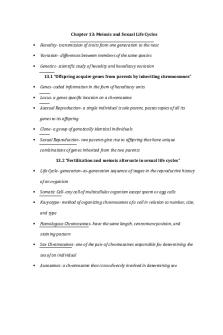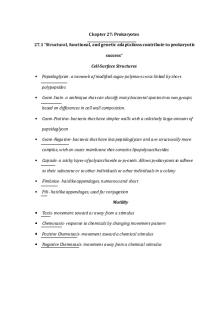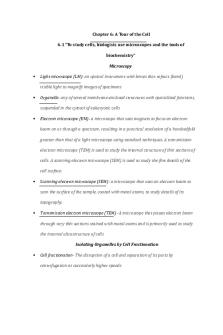Chapter 8 Vocab - Summary Campbell Biology PDF

| Title | Chapter 8 Vocab - Summary Campbell Biology |
|---|---|
| Course | Introduction to Biology A |
| Institution | University of Pennsylvania |
| Pages | 5 |
| File Size | 104.6 KB |
| File Type | |
| Total Downloads | 37 |
| Total Views | 165 |
Summary
Vocab definitions...
Description
Chapter 8: An Introduction to Metabolism 8.1 “An organism’s metabolism transforms matter and energy, subject to the laws of thermodynamics”
Metabolism- the total of an organism's chemical reactions; an emergent property of life that arises from interactions between molecules within the orderly environment of the cell Organization of the Chemistry of Life into Metabolic Pathways
Metabolic Pathway- begins with a specific molecule, which is then altered in a series of defined steps, resulting in a specific product; each step of the pathway is catalyzed by a specific enzyme
Catabolic Pathway- a metabolic process that breaks down complex molecules into simpler compounds; example = cellular respiration because it breaks glucose into carbon dioxide and water; the energy that is stored becomes available to do work within the cell
Anabolic Pathway- a metabolic process that consumes energy to build complicated molecules from simpler molecules
Bioenergetics- the study of how energy flows through living organisms Forms of Energy
Energy- the capacity to cause change
Kinetic Energy- the relative motion of an object
Heat Energy- kinetic energy associated with random movement of atoms or molecules
Potential Energy- the energy that matter possesses because of its location or structure when it is at rest; due to arrangement of atoms
Chemical Energy- the type of energy that refers to the potential energy available for release in a chemical reaction; glucose, for example, has a high amount of this The Laws of Energy Transformation
Thermodynamics- the study of energy transformations that occur in a collection of matter
First Law Of Thermodynamics- a rule that states that the energy of the universe is constant; energy can be transferred and transformed, but it cannot be created or destroyed
Entropy- disorder of the universe
Second Law Of Thermodynamics- a rule that states that every energy transfer or transformation increases the entropy (disorder) of the universe; unstoppable trend toward randomization of the universe as a whole 8.2 “The free-energy change of a reaction tells us whether the reaction occurs spontaneously” Free-Energy Change
Free Energy- the portion of a system's energy that can perform work when temperature and pressure are uniform throughout the system, as in a living cell; this type of energy is a measure of a system's instability, meaning its tendency to change to a more stable state
Free Energy and Metabolism
Exergonic Reaction- the type of reaction that proceeds with a net release of free energy; because the chemical mixture loses free energy, Gibbs free energy is negative; it is a spontaneous reaction
Endergonic Reaction- the type of reaction that absorbs free energy from surroundings; because energy is stored in molecules, Gibbs free energy is positive; the reaction is nonspontaneous 8.3 “ATP powers cellular work by coupling exergonic reactions to endergonic reactions”
Energy Coupling- the use of an exergonic process to drive an endergonic one; ATP is responsible for mediating this, and it acts as an energy source The Structure and Hydrolysis of ATP
ATP- this molecule is composed of ribose, adenine, and a chain of three phosphate groups. Releases free energy when its phosphate groups are hydrolyzed. This energy is used to drive endergonic reactions in cells How ATP Performs Work
Phosphorylated- the state of a molecule when it receives a phosphate, such as in ATP hydrolysis, making it more reactive (less stable) than the original molecule 8.4 “Enzymes speed up metabolic reactions by lowering energy barriers”
Catalyst- a chemical agent that speeds up a reaction without being consumed by the reaction; enzymes are examples of these
Enzyme- a macromolecule that acts as a catalyst; without this, pathways of metabolism would be congested because reactions would take so long
The Activation Energy Barrier
Activation Energy- the initial investment of energy for starting a reaction; the energy required to destabilize the reactant molecules so their bonds can break; also, the amount of energy needed to push reactants over a "hill" so that the "downhill" part of the reaction can begin Substrate Specificity of Enzymes
Substrate - the reactant an enzyme acts on
Enzyme-Substrate Complex- the entity that forms when an enzyme bonds to a substrate, in which the enzyme's catalytic reaction converts the substrate to the product of the reaction
Active Site- a pocket or groove on the surface of an enzyme where catalysis occurs; there is only one of these per enzyme; this is formed by a few amino acids while others construct a frame for it
Induced Fit- the model for enzymes that says that as the substrate and active site approach each other, each influences the other's shape so they mold together; compared to a proper handshake: both entities conform to make a good grip in order to interact Effects of Local Conditions on Enzyme Activity
Cofactors- nonprotein helpers for catalytic reactions; these may be bound tightly to an enzyme as a permanent resident, or may be bound loosely and reversibly along the substrate
Coenzyme- cofactors that are inorganic; examples of these are vitamins
Competitive Inhibitors- reversible inhibitors that resemble the normal substrate molecule and compete for admission into the active site; these reduce productivity by blocking substrates from entering active sites; these can be overcome by producing more substrates to outnumber them; poisons are an example of these with strong bonds
Noncompetitive Inhibitors- these molecules do not directly compete with substrates--instead, they bind to another part of the enzyme, causing it to change its shape so that the active site becomes less effective at conversion 8.5 “Regulation of enzyme activity helps control metabolism” Allosteric Regulation of Enzymes
Allosteric Regulation- this occurs when a molecule bonds to some other location on an enzyme, causing a conformational change, which blocks the active site; after the molecule leaves, however, the enzyme returns to its original shape; may result in either inhibition or enhanced activity of an enzyme
Cooperativity- a mechanism that amplifies the response of an enzyme to a substrate by leading one substrate molecule to prime an enzyme's acceptance of additional substrate molecules
Feedback Inhibition- an occurrence in which a metabolic pathway is switched off by the inhibitory binding of its end product to an enzyme that acts early in the pathway; this prevents the cell from wasting chemical resources; when an end product stops or slows its own production...
Similar Free PDFs

Chapter 8 (campbell biology)
- 8 Pages
Popular Institutions
- Tinajero National High School - Annex
- Politeknik Caltex Riau
- Yokohama City University
- SGT University
- University of Al-Qadisiyah
- Divine Word College of Vigan
- Techniek College Rotterdam
- Universidade de Santiago
- Universiti Teknologi MARA Cawangan Johor Kampus Pasir Gudang
- Poltekkes Kemenkes Yogyakarta
- Baguio City National High School
- Colegio san marcos
- preparatoria uno
- Centro de Bachillerato Tecnológico Industrial y de Servicios No. 107
- Dalian Maritime University
- Quang Trung Secondary School
- Colegio Tecnológico en Informática
- Corporación Regional de Educación Superior
- Grupo CEDVA
- Dar Al Uloom University
- Centro de Estudios Preuniversitarios de la Universidad Nacional de Ingeniería
- 上智大学
- Aakash International School, Nuna Majara
- San Felipe Neri Catholic School
- Kang Chiao International School - New Taipei City
- Misamis Occidental National High School
- Institución Educativa Escuela Normal Juan Ladrilleros
- Kolehiyo ng Pantukan
- Batanes State College
- Instituto Continental
- Sekolah Menengah Kejuruan Kesehatan Kaltara (Tarakan)
- Colegio de La Inmaculada Concepcion - Cebu














